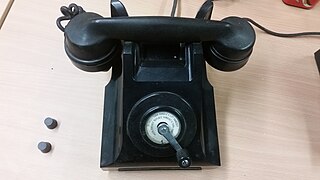Related Research Articles
Telecommunications in the Philippines are well-developed due to the presence of modern infrastructure facilities. The industry was deregulated in 1995 when President Fidel Ramos signed Republic Act No. 7925. This law opened the sector to more private players and improved the provision of telecom services are better and fairer rates, leading to the creation of many telecommunication service providers for mobile, fixed-line, Internet and other services.

Telstra Group Limited is an Australian telecommunications company that builds and operates telecommunications networks and markets related products and services. It is a member of the S&P/ASX 20 and Australia's largest telecommunications company by market share.

Telecommunications in Australia refers to communication in Australia through electronic means, using devices such as telephone, television, radio or computer, and services such as the telephony and broadband networks. Telecommunications have always been important in Australia given the "tyranny of distance" with a dispersed population. Governments have driven telecommunication development and have a key role in its regulation.
Singtel Optus Pty Limited is an Australian telecommunications company headquartered in Macquarie Park, a suburb in the Northern Sydney region of Sydney, New South Wales, Australia. It is a wholly owned subsidiary of Singaporean telecommunications company Singtel.

Internode Pty Ltd is an Australian Internet service provider (ISP) that provides NBN broadband services, business-class broadband access, web hosting, co-location, Voice over IP, and a variety of related services. Internode became part of TPG Telecom in July 2020.

The Overseas Telecommunications Commission (OTC) was established by Australia in August 1946. It inherited facilities and resources from Amalgamated Wireless Australasia (AWA) and Cable & Wireless, and was charged with responsibility for all international telecommunications services into, through and out of Australia. In effect, all overseas telecommunications was nationalized. Australia was adopting a Commonwealth-wide policy that had been adopted at the Commonwealth conference in 1945. The main goal was to end the artificial routing of traffic to cable or wireless depending on private financial profits.

The Postmaster-General's Department (PMG) was a department of the Australian federal government, established at Federation in 1901, whose responsibilities included the provision of postal and telegraphic services throughout Australia. It was abolished in December 1975 and replaced by the Postal and Telecommunications Department. Two separate legal entities had been established in July 1975 to take over the department's operations: Telecom Australia and Australia Post.

The Australia–Japan Cable, or AJC, is a 12,700 km submarine telecommunications cable system linking Australia and Japan via Guam that became operational in 2001. It had an original design capacity of 640 Gbit/s, but was initially equipped to use only 80 Gbit/s of this capacity. In April 2008 a capacity upgrade was completed, bringing equipped capacity to 240 Gbit/s. Design capacity was also increased to 1000 Gbit/s. Further upgrades will increase equipped capacity to meet increasing demand.

A cable landing point is the location where a submarine or other underwater cable makes landfall. The term is most often used for the landfall points of submarine telecommunications cables and submarine power cables. The landing will either be direct or via a branch from a main cable using a submarine branching unit. The branch can be several kilometres long.
SEACOM is a telephone submarine cable linking Hong Kong with Malaysia.
The following lists events that happened during 1946 in Australia.

AWA Technology Services, name based on former name Amalgamated Wireless (Australasia) Ltd, is an Australian provider for technology related services. Throughout most of the 20th century AWA was Australia's largest and most prominent electronics organisation, undertaking development, manufacture and distribution of radio, telecommunications, television and audio equipment as well as broadcasting services.

Cullacabardee is a northeastern rural suburb of Perth, the capital city of Western Australia, located 21 km (13 mi) from Perth's central business district via Alexander Drive or Beechboro Road. It is in the City of Swan local government area. Most of the suburb is covered in native sheoak and banksia forest. A small Noongar community is based on Baal Street, a drug rehabilitation retreat is located off Gnangara Road in the suburb's northeast, and the Perth International Telecommunications Centre facility is based in the suburb's northwest.
The Telstra Endeavour is a submarine cable connecting Sydney and Hawaii. The cable went live in October 2008, with a capacity of 1.28 terabits per second in the future It was proposed on 28 March 2007 by Telstra, the largest telecommunications carrier in Australia.
Internet in Australia first became available on a permanent basis to universities in Australia in May 1989, via AARNet. Pegasus Networks was Australia's first public Internet provider in June 1989. The first commercial dial-up Internet Service Provider (ISP) appeared in capital cities soon after, and by the mid-1990s almost the entire country had a range of choices of dial-up ISPs. Today, Internet access is available through a range of technologies, i.e. hybrid fibre coaxial cable, digital subscriber line (DSL), Integrated Services Digital Network (ISDN) and satellite Internet. In July 2009, the federal government, in partnership with the industrial sector, began rolling out a nationwide fibre-to-the-premises (FTTP) and improved fixed wireless and satellite access through the National Broadband Network. Subsequently, the roll out was downgraded to a Multi-Technology Mix on the promise of it being less expensive and with earlier completion. In October 2020, the federal government announced an upgrade by 2023 of NBN fibre-to-the-node (FTTN) services to FTTP for 2 million households, at a cost of A$3.5 billion.
Internet access is widely available in New Zealand, with 94% of New Zealanders having access to the internet as of January 2021. It first became accessible to university students in the country in 1989. As of June 2018, there are 1,867,000 broadband connections, of which 1,524,000 are residential and 361,000 are business or government.
The Perth International Telecommunications Centre (PITC) is located in the northeastern Perth suburb of Cullacabardee, and has handled a large percentage of Australian telecommunications company Telstra's satellite communications since its opening in November 1986. Most government agencies refer to the site's location as Landsdale or Landsdale-Gnangara.
PacRimWest was a twin-pair 560Mbit/s optical submarine telecommunications cable which served as Australia's main link to the world along with its partner cables Tasman2 and PacRimEast.
TPG Telecom Limited, formerly Vodafone Hutchison Australia and renamed following the merger with TPG, is an Australian telecommunications company. It is the second-largest telecommunications company listed on the Australian Securities Exchange. TPG Telecom is the third-largest wireless carrier in Australia, with 5.8 million subscribers as of 2020.

Wireless Hill Park is a 40-hectare (99-acre) park in Ardross, Western Australia that is the location of the former Applecross Wireless Station, an early radio station in Western Australia. The station buildings have been preserved and now house the Wireless Hill Museum. The site is listed in the Register of the National Estate and the State Register of Heritage Places.
References
- Transit, the official staff magazine of the Overseas Telecommunications Commission
- OTC Annual Reports
- OTC archives
- Overseas Telecommunications Commission